Simon Pridmore moved recently from England to Bali. While exploring land and sea, he stumbles upon an amazing find - a muck dive site that is not well publicised. But he is bothered by a few environmental factors and wonders just how long will the natural habitats be left alone to flourish.
Bali, 20 October 2010. Along Bali’s north shore, away from the tourist hotspots, there are a few great little dive-sites that are infrequently visited.
One of these is Puri Jati. Drive for 20 minutes along the coast road west from Lovina and you come to the small town of Seririt.
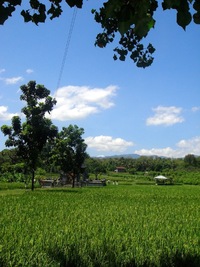
Open rice fields add to Bali's charm.
If you are coming from the south, take the road north out of Denpasar through the mountains, passing through the lakeside market village of Bedugul and sleepy Munduk. If you are lucky with the traffic, it will take you about 3 hours.
Negotiate Seririt’s one-way system and just 500m out of town on the road to Gilimanuk take the track off to the right signposted Zen Resort.
This leads you along a bumpy trail, through a set of split gates and brings you out at the top of a hill overlooking gorgeous rice fields surrounding a large temple and the sea, glassy and glistening beyond. This is Puri Jati.
Drive down to the beach and the track splits in two. Go left to find a row of fishermen’s homes and a second, smaller temple. Go right to find a little shaded beachside facility set up especially for divers. There are fresh water showers, toilets, a small café, concrete gear washing and camera baths and usually a couple of guys around to help you with your gear if you need it. If you don’t need help just say “tidak mau” (I don’t want) with a smile and they will leave you alone.
If you are doing a couple of dives they will ask for a donation of Rp28, 000 (about US$3) for use of the facilities. This goes to the community and theoretically compensates the local people for not fishing on the dive-site. Sadly, as we found, this seems to have only limited effect but it is a small amount to pay and it seems at least some of the locals are trying their best. The facility is clean and very well maintained.
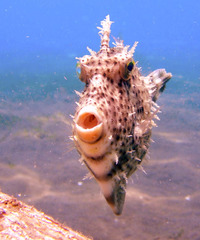
File fish are kinda cute.
Puri Jati diving is what is commonly termed “muck.” The calm bay, particularly around the mouth of a small river, is a haven for octopuses and a nursery for the more unusual creatures found in Indonesia’s seas. At first, you dip below the flat surface and it seems that there is nothing there. But then a trained eye spots what looks like a sprig of weed and, on closer inspection, the weed turns out to be a very rare and exotic Ambon Scorpion fish, with its partner lying perfectly still only centimetres away. As you approach they both start to weave and bob in unison, mimicking the way seaweed moves on a tide.
A few metres further on, you lift a patch of weed to reveal a baby hairy frogfish hiding beneath and a small white mark on the sand turns out to be another baby frogfish relying on its unusual colouring rather than camouflage to protect it.
Every coconut shell and discarded bottle or jars turn out to be the residence of an octopus and they can often be seen scuttling across the sand clutching construction materials to improve their homes. Collapsible juice bags make useful front doors, it seems. When not busy collecting, they bury themselves and their homes deep in the sand. A pile of debris in a pit is a common indicator that here is the lair of an octopus.
This is a holy place so in the morning you may well come upon a prayer ceremony taking place on the sand or a procession coming from the temple to the sea. Mostly, however, you will get the beach to yourselves until late afternoon when mopeds laden with up to four people each bring villagers to swim, bathe, eat and chat on the sand and under the trees. Everyone is very friendly although you will get a few curious stares as you emerge from the shallows in your scuba gear like a big glass-eyed monster from the depths.
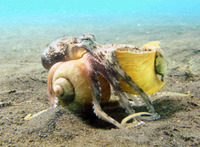
Octopus gathers a shell and coconut for its hideout.
The site slopes out gently along way from the shore until you reach a steeper section, which takes you down to 30 m (100 ft) and more. The slope is good for spotting fingered dragonets, inimicus devilfish, flying gurnards and many kinds of file fish and if you look closely you can find ghost pipefish hanging in the fronds of ferns that decorate the slope like puffy white clouds. These are the home too of unusual yellow, white and black nudibranchs.
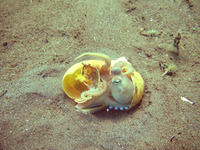
Same octopus hides in coconut.
Curb your environmental instincts and resist the urge to pick up any trash you see lying on the bottom. It is not only the octopus that needs to find creative housing solutions on the featureless sand. A sheet of plastic provides protection from predators and a tin can makes a romantic pied-a-terre for a pair of blennies.
There is no airfill station on the beach but the friendly folk at the Zen resort dive facility a few hundred metres up the track are happy to rent and fill tanks for you. They also provide guided dives and this is one place where a good, experienced guide is worth his or her weight in gold because some of the more exotic of Puri Jati’s residents, such as the highly sought after and little understood mimic octopuses, are so hard to find. When we were there on one occasion we met a couple of photographers who were diving with top Bali operator Aquamarine and they were very grateful for the spotting skills of their divemaster.
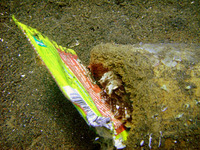
Octopus seals its hideout with a door.
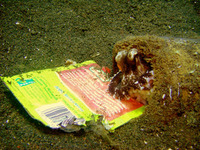
A plastic juice pouch comes in handy.
The best way to appreciate Puri Jati is to dive it at different times of the day so think about staying overnight nearby. The Zen resort offers high-class accommodation or, if you are on a budget, the Bali Nibbana Resort next door has comfortable rooms at cheap prices. Both places have restaurants and freezers full of locally harvested and fresh produce or you can drive into Lovina where virtually every culinary taste is catered for. A popular choice with expat residents is Kakatua. For a quick lunch during your diving day, drive up the track to the main road, turn right (west) and the first café you come to on the right offers a spicy nasi campur for Rp10,000. The friendly couple that run it have absolutely no objection if you turn up in your wetsuit!
For supplies there is a Hardy’s supermarket on the one-way circuit in Seririt that has pretty much anything you might need and is open late into the evening.
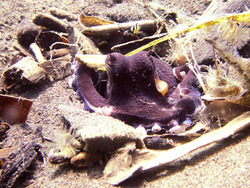
A lair fit for this lordy Cephalopod, possibly a Day Octopus.
If you are asking if Puri Jati is a hidden paradise, especially for underwater photographers, then the answer is, “it can be.” Sadly, it seems that not everyone on this stretch of coast has grasped the concept that the richer the marine life, the more divers will visit the bay and bring much needed economic benefit to the area. Some fishermen, possibly because they see divers coming in and out of the water with smiles on their faces, sneak into the bay from time to time at night and drag weighted nets along the seabed.
This is not completely disastrous. The more enlightened villagers have placed snares in the shallows to snag the nets and try and disrupt this activity, the nets don’t succeed in scouring the site completely and the marine life does return after a little while but there is bound to be some long term attrition and the site could be even better and an even bigger draw if it remained pristine and untouched.
Finds like Puri Jati are all too rare, so when you visit, take the opportunity to emphasise to everyone you meet the long-term benefits of protecting the site for divers. Point out that the reason people visit the site is not to see big fish but to see tiny marine creatures that are a valuable resource ONLY if they are left where they are.
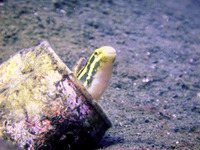
Blenny passes the day in a can.
Tell the waitress in your hotel, the guy who serves you in the bar, the children who come up to you on the beach to practice their English. That way the word will get around; the people around here have a chance to steal at least a few of Bali’s tourist dollars away from their cousins in the affluent south. If the divers stop coming, however, Puri Jati will sink back into peaceful but penniless oblivion!
Photographs courtesy of Simon Pridmore.
Contacts and Connections
Bali Nibbana Resort: www.balinibbanaresort.com/
Zen Resort www.zenresortbali.com/
Blue Season Dive Centre at Zen: www.bali-diving-resort.com/
Aquamarine Diving: www.aquamarinediving.com/
Kakatua Restaurant, Jalan Pantai Binaria, Lovina 0362-41144/41344
